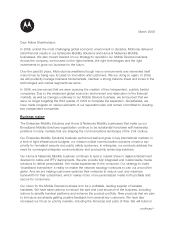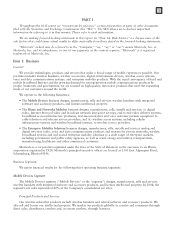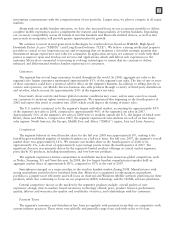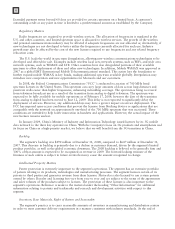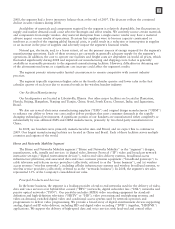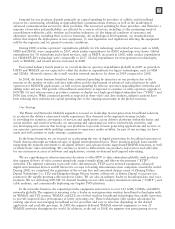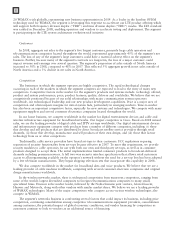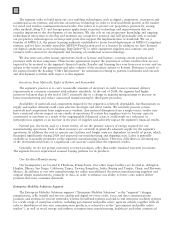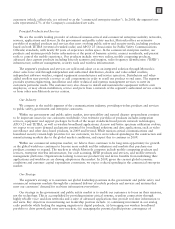Motorola 2008 Annual Report Download - page 13
Download and view the complete annual report
Please find page 13 of the 2008 Motorola annual report below. You can navigate through the pages in the report by either clicking on the pages listed below, or by using the keyword search tool below to find specific information within the annual report.
2008, the segment had a lower inventory balance than at the end of 2007. The decrease reflects the continued
decline in sales volumes during 2008.
Availability of materials and components required by the segment is relatively dependable, but fluctuations in
supply and market demand could cause selective shortages and affect results. We currently source certain materials
and components from single vendors. Any material disruption from a single-source vendor may have a material
adverse impact on our results of operations. If certain key suppliers were to become capacity constrained or
insolvent as a result of the ongoing global financial crisis, it could result in a reduction or interruption in supplies
or an increase in the price of supplies and adversely impact the segment’s financial results.
Natural gas, electricity, and, to a lesser extent, oil are the primary sources of energy required for the segment’s
manufacturing operations. Each of these resources are currently in generally adequate supply for the segment’s
operations. In addition, the cost to operate our facilities and freight costs are dependent on world oil prices, which
fluctuated significantly during 2008 and impacted our manufacturing and shipping costs. Labor is generally
available in reasonable proximity to the segment’s manufacturing facilities. However, difficulties in obtaining any
of the aforementioned items or a significant cost increase could affect the segment’s results.
The segment permits returns under limited circumstances to remain competitive with current industry
practices.
The segment typically experiences higher sales in the fourth calendar quarter and lower sales in the first
calendar quarter of each year due to seasonal trends in the wireless handset industry.
Our Facilities/Manufacturing
Our headquarters are located in Libertyville, Illinois. Our other major facilities are located in Plantation,
Florida; Beijing, Hangzhou, Nanjing and Tianjin, China; Seoul, South Korea; Chennai, India; and Jaguariuna,
Brazil.
We also use several electronics manufacturing suppliers (“EMS”) and original design manufacturers (“ODM”)
to enhance our ability to lower our costs and/or deliver products that meet consumer demands in the rapidly-
changing technological environment. A significant portion of our handsets are manufactured either completely or
substantially by non-affiliated EMS and ODM manufacturers, primarily by two third-party manufacturers in
China.
In 2008, our handsets were primarily manufactured in Asia and Brazil, and we expect this to continue in
2009. Our largest manufacturing facilities are located in China and Brazil. Each of these facilities serves multiple
countries and regions of the world.
Home and Networks Mobility Segment
The Home and Networks Mobility segment (“Home and Networks Mobility” or the “segment”) designs,
manufactures, sells, installs and services: (i) digital video, Internet Protocol (“IP”) video and broadcast network
interactive set-tops (“digital entertainment devices”), end-to-end video delivery systems, broadband access
infrastructure platforms, and associated data and voice customer premise equipment (“broadband gateways”) to
cable television and telecom service providers (collectively, referred to as the “home business”), and (ii) wireless
access systems (“wireless networks”), including cellular infrastructure systems and wireless broadband systems, to
wireless service providers (collectively, referred to as the “networks business”). In 2008, the segment’s net sales
represented 33% of the Company’s consolidated net sales.
Principal Products and Services
In the home business, the segment is a leading provider of end-to-end networks used for the delivery of video,
data and voice services over hybrid fiber coaxial (“HFC”) networks, digital subscriber line (“DSL”) networks and
passive optical networks (“PON”). Our portfolio includes: MPEG video encoding equipment for standard-
definition and high-definition television (“HDTV” or “HD”); video processing and multiplexing systems; and
video-on-demand, switched digital video and conditional access systems used by network operators and
programmers to deliver video programming. We provide a broad array of digital entertainment devices supporting
analog, digital and IP video delivery, including HD and digital video recording (“DVR”) (together, “HD/DVR”)
applications. We support the delivery of high-speed data and voice services with head-end and central office
5


